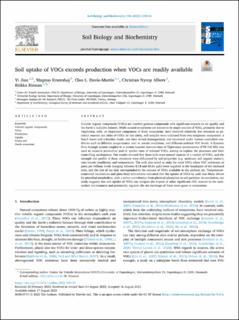| dc.contributor.author | Jiao, Yi | |
| dc.contributor.author | Kramshøj, Magnus | |
| dc.contributor.author | Davie-Martin, Cleo Lisa | |
| dc.contributor.author | Albers, Christian Nyrop | |
| dc.contributor.author | Rinnan, Riikka | |
| dc.date.accessioned | 2023-11-01T10:03:19Z | |
| dc.date.available | 2023-11-01T10:03:19Z | |
| dc.date.created | 2023-09-20T10:47:17Z | |
| dc.date.issued | 2023 | |
| dc.identifier.citation | Soil Biology and Biochemistry. 2023, 185, 109153. | en_US |
| dc.identifier.issn | 0038-0717 | |
| dc.identifier.uri | https://hdl.handle.net/11250/3099936 | |
| dc.description.abstract | Volatile organic compounds (VOCs) are reactive gaseous compounds with significant impacts on air quality and the Earth's radiative balance. While natural ecosystems are known to be major sources of VOCs, primarily due to vegetation, soils, an important component of these ecosystems, have received relatively less attention as potential sources and sinks of VOCs. In this study, soil samples were collected from two temperate ecosystems: a beech forest and a heather heath, and then sieved, homogenized, and incubated under various controlled conditions such as different temperatures, oxic vs. anoxic conditions, and different ambient VOC levels. A dynamic flow-through system coupled to a proton transfer reaction-time of flight-mass spectrometry (PTR-ToF-MS) was used to measure production and/or uptake rates of selected VOCs, aiming to explore the processes and their controlling mechanisms. Our results showed that these soils were natural sources of a variety of VOCs, and the strength and profile of these emissions were influenced by soil properties (e.g. moisture, soil organic matter), oxic/anoxic conditions, and temperature. The soils also acted as sinks for most VOCs when VOC substrates at parts per billions levels (ranging between 0.18 and 68.65 ppb) were supplied to the headspace of the enclosed soils, and the size of the sink corresponded to the amount of VOCs available in the ambient air. Temperature-controlled incubations and glass bead simulations indicated that the uptake of VOCs by soils was likely driven by microbial metabolism, with a minor contribution from physical adsorption to soil particles. In conclusion, our study suggests that soil uptake of VOCs can mitigate the impact of other significant VOC sources in the near-surface environment and potentially regulate the net exchange of these trace gases in ecosystems. | en_US |
| dc.language.iso | eng | en_US |
| dc.rights | Navngivelse 4.0 Internasjonal | * |
| dc.rights.uri | http://creativecommons.org/licenses/by/4.0/deed.no | * |
| dc.title | Soil uptake of VOCs exceeds production when VOCs are readily available | en_US |
| dc.title.alternative | Soil uptake of VOCs exceeds production when VOCs are readily available | en_US |
| dc.type | Peer reviewed | en_US |
| dc.type | Journal article | en_US |
| dc.description.version | publishedVersion | en_US |
| dc.rights.holder | © 2023 The Authors. Published by Elsevier Ltd. | en_US |
| dc.source.volume | 185 | en_US |
| dc.source.journal | Soil Biology and Biochemistry | en_US |
| dc.identifier.doi | 10.1016/j.soilbio.2023.109153 | |
| dc.identifier.cristin | 2176917 | |
| dc.source.articlenumber | 109153 | en_US |
| cristin.ispublished | true | |
| cristin.fulltext | original | |
| cristin.qualitycode | 2 | |

